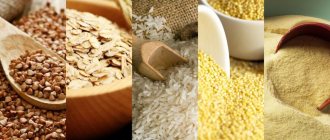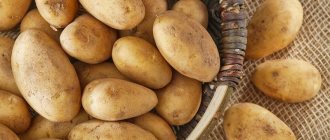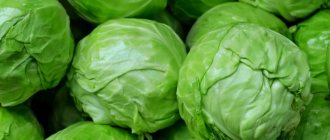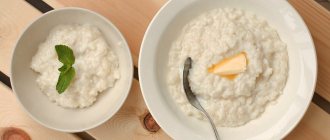The birth of a baby and subsequent worries raise many questions among young mothers. This is especially true for nutrition issues - that’s where myths are made up! Inexperienced mothers in labor are lost in prohibitions and permissions, afraid of accidentally harming the newborn. It’s impossible to address all the questions in one article, but I will try to answer one in detail. Our site is about cottage cheese, and therefore we will consider a common question that is asked to pediatricians: is it possible to use cottage cheese while breastfeeding and in what quantity is it safe to consume.
By the way, here is how to properly introduce cottage cheese into complementary foods for infants.
Useful product
It's no secret that you can and should eat cottage cheese. We are told about this from early childhood, promising muscle growth and increased mental activity. Cottage cheese dishes are not only healthy, but also very tasty.
Fermented milk products, and in particular cottage cheese, have an invariably positive effect on the body, namely:
- promote rapid protein absorption;
- improve the removal of urine and bile from the body;
- are the prevention of pancreatic diseases;
- help the liver function;
- restore the nervous system;
- increase the level of hemoglobin in the blood;
- improve the functioning of the cardiovascular system;
- lower blood pressure.
As you can see, the list of useful properties is impressive. But are fermented milk products acceptable during breastfeeding?
Composition of cottage cheese
Cottage cheese is a source of proteins, fats, vitamins, and minerals that have a beneficial effect on the human body.
Table: Composition of cottage cheese and its beneficial properties.
| Name of vitamin or mineral | Main action |
| A | Improving the functionality of the visual organ, slowing down aging, beneficial effects on the structure of the skin and hair. |
| B1 | Normalization of the gastrointestinal tract, help with stress. |
| B2 | Active participation in metabolic processes, feeding cells with oxygen, burning sugar compounds, eliminating peeling of the skin. |
| B5 | Strengthening and restoring the protective functions of the human body, fighting cellulite. |
| B6 | Lowering cholesterol levels, preventing itchy skin and central nervous system disorders. |
| B9 | Strengthening the immune system, improving mental state, maintaining performance. |
| WITH | Increasing mood and protective properties of the body, protection against colds and viral diseases, eliminating depression and weakness. |
| E | Restoration of the female body after childbirth, normalization of hormonal levels. |
| Mg (magnesium) | Normalizing heart rate, relieving tension, forming tooth enamel. |
| Ca (calcium) | Reducing cholesterol levels, ensuring normal blood clotting, strengthening bones and teeth. |
| K (potassium) | Normalization of blood pressure, stimulation of brain activity. |
| Na (sodium) | Regulates blood pressure, increases the body's endurance, normalizes heartbeat. |
| P (phosphorus) | Improving memory and brain function, strengthening bones and teeth, increasing performance. |
| S (sulfur) | Fighting pathogenic microorganisms, slowing down the aging process, normalizing the functionality of the gastrointestinal tract. |
| Cl (chlorine) | Eliminates swelling, breaks down fats, improves liver function, increases appetite. |
We recommend reading: Drying while breastfeeding
Is cottage cheese suitable for nursing mothers and what kind?
Does a nursing mother need cottage cheese? Of course, the animal protein in this product will provide a nursing woman with considerable benefits. It is easily absorbed by the body and is included in metabolic processes. As a result, the mother’s body recovers more quickly after childbirth. Also, consuming cottage cheese while breastfeeding can increase the amount of mother's milk. Cottage cheese also compensates for the lack of calcium in the body of a nursing mother during breastfeeding.

As a rule, a young mother has many questions regarding this product in her diet. Here are the most common ones.
Is it possible for mom to eat cottage cheese with sour cream during pregnancy?
Yes, you can. This mixture is a source of large amounts of protein, vitamins and beneficial elements. But do not forget that this combination has increased fat content. Therefore, it should be introduced into the diet when the baby is 3 months old. All the “benefits” relate only to very high-quality, homemade cottage cheese and sour cream. Do not forget that store-bought products are not always safe. Pay attention to the label. The correct product should contain only whole milk (sometimes with the addition of skim milk), plus lactic acid bacteria. There should be no preservatives or flavors. Powdered milk is also an undesirable component.
Can nursing mothers eat curd mass?
And again, the answer is yes. And again: if the curd mass is “correct”. You should not get carried away with the mass bought in the store, especially with various flavoring additives (chocolate, vanilla, etc.). It's best to make this delicacy yourself. Cottage cheese blended in a blender with sugar will be much healthier than store-bought counterparts. To enhance the taste, you can add raisins or dried fruits to the dish. But think of this product as a dessert and eat it in “dessert” doses. You can eat sugar during breastfeeding, but only a little bit.
How much cottage cheese can a nursing mother eat per day?
For the full functioning of all body systems, it is enough to eat 100-200 g of product per day. If you want more, and the baby does not have an allergic reaction, you can do more.
Fat, low-fat, low-fat - which cottage cheese to choose while breastfeeding?
It is better for a nursing mother to avoid overly fatty versions of cottage cheese. They negatively affect the liver and contribute to the gain of extra pounds. A low-fat product is also a “so-so” option, since calcium (necessary for a nursing mother) and many vitamins without fat are absorbed very poorly. In addition, low-fat foods taste very bland and do not satisfy hunger. And remember: a woman needs animal fat (in moderation, of course), especially if she is breastfeeding. The lack of animal fats in the diet leads to hormonal imbalance and hypovitaminosis.
It is best to choose a product with a fat content of 5%, maximum 9%. If your mother is overweight and wants to lose weight, choose a fat content of 3-5%.
How soon after the birth of a child should cottage cheese be introduced into the mother’s menu?
In principle, this product is allowed for a nursing mother in the first month of a newborn’s life. It is considered one of the safest. However, it would be a good idea to wait at least a week or two so as not to harm the newborn.
When and why should you not eat raisins while breastfeeding?
If you eat the product in small quantities, then most likely no negative reactions will occur. They accompany unlimited nutrition. A large amount of sugar means high calorie content of dried fruits, so people who are overweight or those who are losing weight should limit the amount of raisins in their diet.
The treat is an allergen. That is why it should not be eaten in the first months after childbirth. Allergies can occur in a baby even if the mother accepts the product well. Symptoms may include rash, itching, skin spots, cough, watery eyes, etc. If you notice such signs in your baby, immediately discard the product and consult a doctor. Due to the high sugar content, an infant may develop diathesis. Despite this, raisins are safer for breastfeeding than honey.
Child's reaction to cottage cheese
Cottage cheese during lactation, just like other fermented milk products, has a strong effect on the body of mother and baby. Most often, this influence is positive. But it is worth considering that such products, despite all their benefits, can cause problems in the baby’s body.
A nursing mother can use cottage cheese (of course, within acceptable limits). However, cottage cheese, as well as any other new product, can cause undesirable processes in the baby’s body.
The popular children's doctor Komarovsky is considered a supporter of cottage cheese and fermented milk products. It is not for nothing that complementary feeding according to his scheme begins with kefir and cottage cheese with the further introduction of cereals, vegetables and other products. But consuming sour milk, like any other product, is an individual matter. Do not also forget about the strict dosage when consuming any fermented milk product.
The child’s immature body may accept the incoming cottage cheese as an enemy agent and turn on defensive reactions. And all because of the milk protein content in the product. If a baby has an intolerance to cow's milk, sometimes an allergy to cottage cheese occurs in the infant. Defense mechanisms result in the following reactions that may occur against the background of such nutrition:
- Problems with the gastrointestinal tract: the baby becomes stronger or, on the contrary, weakens, spasms, colic, and gas formation occur.
- A rash may appear on the face and body - this is the main sign of an allergy.
However, cottage cheese is much safer during breastfeeding than whole milk. The secret is that lactic acid bacteria soften the effect of milk protein and help them to be absorbed correctly. Therefore, the reaction occurs infrequently.
In general, cottage cheese has the most beneficial effect on the health of the baby. However, we should not forget that every organism (even the smallest) is individual. A particular child may react to fermented milk foods in an unconventional way. In this case, mom should remove cottage cheese from the menu for a while. Or switch to cheesecakes and casseroles: heat treatment will help neutralize allergic reactions.
Composition and role of individual components
- Proteins ensure intensive growth and development of the child’s body and maintain water balance.
- Fats are the main source of energy for a mother and her newborn baby.
- Calcium helps strengthen and properly develop the baby’s teeth and bone tissue, and is also involved in the prevention of rickets.
- Potassium improves the functioning of the children's cardiovascular system, is responsible for muscle strength and stable functioning of the small intestines.
- Magnesium stabilizes blood pressure, normalizes blood sugar levels, participates in the breakdown of carbohydrates, strengthens the nervous system of a nursing mother and promotes restful sleep in a newborn.
- Iron is involved in metabolism and oxygen synthesis in the mother’s body; it is necessary for the proper development and full functioning of the infant’s immune system.
- Phosphorus ensures normal growth of bone and dental tissues in babies and prevents the development of rickets.
- Vitamin PP normalizes metabolism; participates in energy production, promotes the complete absorption of proteins, fats and mineral components in the baby’s body.
- Vitamin B1 is involved in metabolism and is responsible for the full development of the visual organs in infants.
- Vitamin B2 promotes the full functioning of the skin of a woman and child and promotes the harmonious growth and development of the child’s body.
- Vitamin C is a recognized antioxidant that increases the resistance of mother and baby to viral infections.
Dumplings for breastfeeding.
Is it necessary to eat cottage cheese while breastfeeding?
Of course, no one forces a mother to eat cottage cheese while breastfeeding a newborn if she doesn’t want to. Also, no one limits it - of course, if the baby does not have allergies. It is important to remember that any dish should bring pleasure to the nursing mother. If you force yourself to eat healthy but unloved foods, this will negatively affect the mother’s emotional state and her digestion. And of course, do not forget about moderation and dosage. With this approach, cottage cheese during breastfeeding will bring only benefit and pleasure to mother and baby.
In other words, consuming curd products during lactation is desirable, but not necessary - it is quite acceptable to replace it with other healthy high-protein foods. But it is imperative to follow certain rules for consuming this fermented milk product:
- When purchasing fermented milk products on store shelves, you need to pay close attention to the composition and expiration dates of the purchase.
- Store-bought cottage cheese must be consumed within three days after opening the package.
- Berries and fruits should be added to cottage cheese with caution, and not earlier than the baby is 3 months old.
Cottage cheese dishes during lactation
If a nursing woman does not like the taste of this product, it is not at all necessary to eat it in its pure form. A nursing mother can use cottage cheese as a base for other tasty and healthy dishes.
Homemade cottage cheese recipe
This dish is prepared using sour milk that has undergone heat treatment.
The cooking process includes the following steps:
- Place the pan with yogurt poured into it in a water bath, waiting for the whey to completely separate.
- Prepare a piece of gauze and a colander.
- Pour the contents of the pan into a colander. The liquid drains off, but the cottage cheese remains in the colander.
- Hang the resulting curd in gauze at a height. Another option is to leave it in a colander and press it with a press. The holding time for the resulting mass is 1-3 hours.
Cottage cheese casserole
One of the most popular dishes during lactation is, of course, a casserole for a nursing mother. It is made according to this recipe:
- 3 tablespoons of sour cream are combined with 2 tablespoons of semolina, the resulting mass is left for half an hour.
- Any dried fruit in the amount of 50 g is poured with boiling water and set aside for about 20 minutes.
- All prepared components are mixed with 500 g of cottage cheese, followed by a chicken egg, 3 tbsp. sugar, a pinch of salt.
- The prepared pan is greased with oil, the curd mass is poured into it and baked for 40 minutes in an oven preheated to 180 degrees.
When the casserole is baked, it is carefully removed from the mold and enjoyed as a great dessert for a nursing mother.
Dumplings with dough and lazy dumplings
Is it possible for nursing mothers to have dumplings with cottage cheese? Of course, if they are made by caring hands at home and using the highest quality products. To prepare the dish you will need:
- Cottage cheese - 500 g;
- Eggs - 2 pcs.;
- Water - 150 g;
- Flour - 3 cups;
- Vegetable oil - 1 tbsp;
- Salt, sugar - to taste;
- Sour cream - for seasoning the finished dish.
Water, salt, sugar, 1 egg and butter are mixed together. The resulting mass is gently whisked with a fork, flour is gradually introduced, and a stiff dough is kneaded. The cottage cheese is blended in a blender, after which an egg beaten with a fork and sugar to taste are added. The resulting mixture is mixed with the dough and kneaded thoroughly. The dough is rolled out, circles are cut using a glass. The dumplings are given the desired shape.
Dumplings are thrown into boiling water and cooked for 3-4 minutes. The finished dish is placed on a plate and mixed with sour cream.
After making sure that a nursing mother can eat dumplings, do not forget about moderate portions of the delicacy eaten.
Cheesecakes in the oven
Cheesecakes, or cottage cheese, are another healthy dish made from cottage cheese during breastfeeding. To prepare them you will need:
- 100 g cottage cheese;
- 1 chicken egg;
- 2-3 tbsp. l. semolina.
- Sugar to taste.
All ingredients are mixed together.
Small pancakes are formed from the resulting mass. They are placed on a prepared baking sheet and baked for approximately 15-17 minutes. Cottage cheese is an extremely healthy delicacy. For a mother who has endured the difficulties of pregnancy and childbirth and is getting used to the process of lactation, such a product will become completely indispensable. However, the benefits of this product do not mean that you need to eat kilograms of it, hoping for a miraculous effect. Normalcy and restraint are the mother’s main motto during this period. Do not forget that cottage cheese, like any other new product, may not have the best effect on the baby’s health. It is for this reason that when introducing fermented milk products into the diet, you need to carefully monitor the child’s reaction. At the slightest sign of allergic reactions or gastric disorders in the baby, the mother should immediately exclude the questionable product for a while.
How to cook at home?
- You can make cottage cheese yourself at home from sour milk using heat treatment.
- To obtain a high-quality mass, the pan with yogurt must be left to simmer in a water bath until the whey is completely separated and separated.
- Next you will need a colander and cheesecloth.
- When you pour the liquid into a colander, the whey will drain, and the curd will remain in the gauze, which will then need to be hung to remove excess moisture.
In addition to homemade curdled milk, fresh milk can also serve as a raw material, but a little sour cream or kefir is added to it as a starter.
This method allows you to relatively quickly obtain the required amount of fresh cottage cheese daily.










